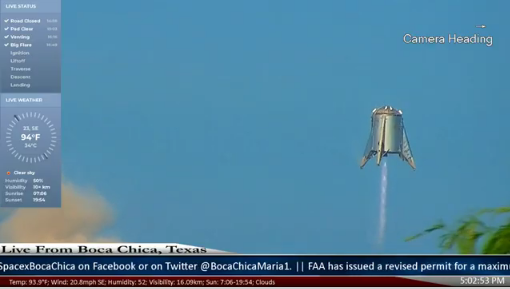Starhopper: Success!
It appears today’s 150 meter hop (about 500 feet) of SpaceX’s Starhopper prototype was a complete success. To the right, and also below, are screen captures grabbed by me from one private live stream as well as from SpaceX’s own live stream.
In fact, this quick hop appears to have gone amazingly smoothly. It launched almost exactly at the target time, and landed quite softly on the launchpad, as intended. You can see the nozzle of the Raptor engine shifting and adjusting throughout the flight, also another indication that their engineering here is working perfectly. Congratulations SpaceX!
I have embedded SpaceX’s video below the fold. The flight begins around 30 minutes in.



On Christmas Eve 1968 three Americans became the first humans to visit another world. What they did to celebrate was unexpected and profound, and will be remembered throughout all human history. Genesis: the Story of Apollo 8, Robert Zimmerman's classic history of humanity's first journey to another world, tells that story, and it is now available as both an ebook and an audiobook, both with a foreword by Valerie Anders and a new introduction by Robert Zimmerman.
The print edition can be purchased at Amazon or from any other book seller. If you want an autographed copy the price is $60 for the hardback and $45 for the paperback, plus $8 shipping for each. Go here for purchasing details. The ebook is available everywhere for $5.99 (before discount) at amazon, or direct from my ebook publisher, ebookit. If you buy it from ebookit you don't support the big tech companies and the author gets a bigger cut much sooner.
The audiobook is also available at all these vendors, and is also free with a 30-day trial membership to Audible.
"Not simply about one mission, [Genesis] is also the history of America's quest for the moon... Zimmerman has done a masterful job of tying disparate events together into a solid account of one of America's greatest human triumphs."--San Antonio Express-News
It appears today’s 150 meter hop (about 500 feet) of SpaceX’s Starhopper prototype was a complete success. To the right, and also below, are screen captures grabbed by me from one private live stream as well as from SpaceX’s own live stream.
In fact, this quick hop appears to have gone amazingly smoothly. It launched almost exactly at the target time, and landed quite softly on the launchpad, as intended. You can see the nozzle of the Raptor engine shifting and adjusting throughout the flight, also another indication that their engineering here is working perfectly. Congratulations SpaceX!
I have embedded SpaceX’s video below the fold. The flight begins around 30 minutes in.



On Christmas Eve 1968 three Americans became the first humans to visit another world. What they did to celebrate was unexpected and profound, and will be remembered throughout all human history. Genesis: the Story of Apollo 8, Robert Zimmerman's classic history of humanity's first journey to another world, tells that story, and it is now available as both an ebook and an audiobook, both with a foreword by Valerie Anders and a new introduction by Robert Zimmerman.
The print edition can be purchased at Amazon or from any other book seller. If you want an autographed copy the price is $60 for the hardback and $45 for the paperback, plus $8 shipping for each. Go here for purchasing details. The ebook is available everywhere for $5.99 (before discount) at amazon, or direct from my ebook publisher, ebookit. If you buy it from ebookit you don't support the big tech companies and the author gets a bigger cut much sooner.
The audiobook is also available at all these vendors, and is also free with a 30-day trial membership to Audible.
"Not simply about one mission, [Genesis] is also the history of America's quest for the moon... Zimmerman has done a masterful job of tying disparate events together into a solid account of one of America's greatest human triumphs."--San Antonio Express-News



Nailed it!
Successful flight!
The Hopper has Landed!
Yes !!!
https://youtu.be/diRx8nRk6e0
Seems more like it belongs in this movie.
Impressed with how smooth the Raptor engine looks. Can’t wait to see multiples engines firing at the same time. Exiting to witness the progress these guys are making in real time and in front of the public eye. Very accurate and deliberate maneuvering via engine nossle control. Perfect landing. Awesome.
Sorry. Typos are inevitable when using a cell phone to post.
Autocorrect is one of The Great Ironies of our time.
Congratulations SpaceX!
I noticed that they performed a roll of about 180 degrees. They also seem to have changed the fuel to oxidizer ratio just before landing.
Edward – Saw that too. Looked like the jet turned from blue-green to orange. Wonder what the mix transitioned to at landing?
The most advanced rocket in the world, built on a beach in Texas, by water tank welders. Capitalism at its finest!
Edward and Shaun, Scott Manley commented on Nasaspaceflight.com that the change in exhaust color is caused by it mixing with the dust that it stirs up near the ground cooling it, ending up with the Blue color up in the sky and the orange near the ground.
I realize that aesthetics isn’t the concern here, but it sure looks to me like a flying garbage can (or maybe a flying fire plug). Just sayin’….
Col Beausabre:
Flying water tank….
I watched this thing live at 1700 CT…. Awsome doesn’t even try to describe the moment……
Fantastic, have to remind oneself how big that thing is.
And the dust! Reminded me of “kicking up some dust” from Aldrin, I wonder if they realized just how much dust beforehand.
Certainly, the O / F mixing ratio was not changed. Such an approach would be very unusual and probably would not be good for the engine itself. It can be seen very well in the video that the change in color of the exhaust/ gas jet, when Starhopper is approaching the ground, emanates from there and spreads towards direction of the engine’s nozzle and of the approaching Starhopper. That would not be the case when changing the mixing ratio.
Complement to my comment above: If you look at the launch, you can recognize exactly the reverse process regarding the color of the jet. It is a clear effect that is produced by fluidized material from the ground.
As impressive as the flight was, there is so much more going on here. This is the most efficient rocket engine ever, with all fuel and LOX running through the combustion chamber – including exhaust from the turbopumps. The Russians tried it, and NASA tried it, but this is the first time such a design has flown. It’s also the first major engine using methane, so SpaceX is learning all the ground support processes for storing, fueling, and detanking methane (mostly) safely. (Still causing grass fires at launch…) They’re aiming for production cost below $2M per Raptor, and they’re about ready to go full production on the engines, around 500 engines per year.
Congratulations to SpaceX on all counts!
Shiny saver, isn’t that what I said above, about the exhaust, only a little less fancy, more in layman’s terms.
Diane Wilson: You sum this up better with your comment than anyone so far has. I might quote you, and hat tip you if I do.
Diane Wilson:
I do not think that there is a need for 500 Raptor engines a year. That would be about 12 BFR rockets a year. That makes no sense to me, because SpaceX has planned that this space launch system should be fully reused hundreds of times and at that minimal cost per launch. By the way, we should be, in respect to price and cost numbers, which are presented by SpaceX, very careful. I do not trust them. So, we still do not know what cost advantage the reuse of the first stage of the F9 really results. Unit costs of only $ 2 million – for one of the most complex liquid rocket engine that has been built so far are – are in my view, totally unbelievable. I just want to like how this number was generated.
Methane as a fuel for a liquid rocket propellant combination owns advantages and also disadvantages. Its Isp performance is not much larger as that of RP-1 kerosene fuel, in combination with LOX as oxidizer. Its main advantages are its properties as coolant for the combustion chamber’s regenerative cooling system. For example, it does not produce soot as a coolant, which can block cooling passages. However, it is much more hazardous in respect of unwanted ignition of air (oxygen)-methane-mixture, because its ignition energy is very low. In this respect, RP-1 is much less hazardous. And methane is cryogenic. Methane has to vent permanently during propellant loading, parallel to LOX venting, which is not ideal in respect to ignition hazards and environmental impact.
Shiny Saver, keep in mind that Musk’s goal is Mars. That calls for a lot more rockets, as well as orbital refueling, requiring multiple launches per mission. 500 is Musk’s goal, and it’s on his pennies. I’ll play along and see whether he makes that number, and what he does with them.
Musk has said that he wants to die on Mars, just not on impact. This will get very interesting, very soon.
It seems that Starhopper was lucky with its successful flight! Look closely. At 1:19 min, a pressurized gas tank flies away, just in moment of landing, probably one of the white pressure vessel for helium or nitrogen mounted on top of Starhopper. What do you say?
https://www.youtube.com/watch?time_continue=412&v=lsoS6C0uzGY
Brian noted: “Scott Manley commented on Nasaspaceflight.com that the change in exhaust color is caused by it mixing with the dust that it stirs up near the ground cooling it, ending up with the Blue color up in the sky and the orange near the ground.”
That makes sense. The yellow was also there early in the launch, and during landing it formed from lower down the exhaust upward.
Shiny saver wrote: “Certainly, the O / F mixing ratio was not changed. Such an approach would be very unusual and probably would not be good for the engine itself.”
Not necessarily. The Saturn V changed mix ratios in order to change performance to get the most out of the rocket.
Shiny saver wrote: “Unit costs of only $ 2 million – for one of the most complex liquid rocket engine that has been built so far are – are in my view, totally unbelievable.”
This price depends upon several things. For instance, it is a target price, not a guaranteed cost of production. Mass production of 500 per year will reduce the fixed costs on a per-engine basis. Additive manufacturing is becoming a mature process, and engineers are finding ways to reduce the number of individual parts that must be assembled.
Additive manufacturing is also reducing the weight used on flanges for bolting pieces together. It is a process that is paying off in several ways.
No matter what, SpaceX is committed to lowering the cost of getting into space, even over rocket performance. They use the less efficient RP1 in the Falcon upper stage in order to reduce the costs associated with using two different types of fuels. This low-cost philosophy is spilling over into the BFR rocket, and attempting to reduce the cost of each engine would be an important goal. Because so many are used in each Super Heavy (SH), reducing the per-engine cost would be a high priority.
As ULA notes, returning a Falcon first stage reduces the mass that can be lifted into space, and ULA’s new design tries to maximize performance while only returning the expensive engines for reuse. ULA is willing to pay the price of building new first stage bodies for each launch in order to keep the performance high, but SpaceX would rather offer a launch for a lower price than maximize its first stage performance.
Why would SpaceX need a dozen SHs a year? Outside of the possibility that sometime in the future there may be a market for using them for lifting masses that require they be thrown away (expensive, but may be necessary), SpaceX may not be able to turn-around each SH as fast as they need them, so they may need multiple SH stages at each launch site.
As Diane Wilson noted, SpaceX wants to go to Mars. They have announced that they want to move a million people there, and that will take a lot of Starships and SHs as well as quite a few tanker versions of Starship.
There is the concept of using Starship for point to point Earth travel. Look at the bottom of this page:
https://www.spacex.com/mars
SpaceX lists eight different routes between ten different cities, so they need at least three (but probably eight) Starships and at least ten Super Heavies. If these routes prove to be popular, then they may need even moire. And if other routes are created, then more of these rockets will be needed.
Shiny Saver wrote: It seems that Starhopper was lucky with its successful flight! Look closely. At 1:19 min, a pressurized gas tank flies away, just in moment of landing, probably one of the white pressure vessel for helium or nitrogen mounted on top of Starhopper. What do you say?
I’ve only seen speculation so far on what that might have been, but it seems to have been something from the underside of StarHopper, possibly a pressure vessel, and possibly from the engine vectoring controls. All of the white pressure vessels on top of StarHopper are still there.
Lucky? There’s a saying that luck favors the prepared. They’ve had their failures, and they’ve learned from them. They have an acronym, “RUD”, for “rapid unscheduled disassembly.” This was a test vehicle and a test engine, built for testing. If nothing goes wrong in testing, it only means that you haven’t pushed hard enough.